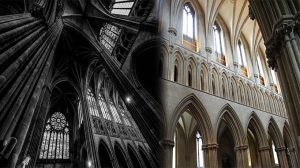If you’re not familiar with Gothic architecture, you may be picturing something dark and gloomy—a castle with medieval torture chambers and dungeons. In fact, this architectural style was named after the French word for “barbarian” or “foreigner,” which was how medieval Europeans referred to people from outside their region. But that doesn’t mean Gothic architecture has to be scary! Gothic buildings are often characterized by tall spires (called towers), pointed arches (often in windows), ribbed stone vaulting (the kind used in cathedrals), flying buttresses (stones that support walls), rose windows (circular stained glass), and other features. If you’re interested in seeing some of the most famous examples of gothic architecture around the world today, keep reading!
Here are some of the most famous examples of gothic architecture.
Gothic architecture is one of the most famous styles in the world. Some of the most famous examples include Notre Dame Cathedral in Paris, Westminster Abbey in London and Milan Cathedral. Cologne Cathedral is also a great example of gothic architecture because it was built around 1400 AD and is still standing today!
Other examples include St Patrick’s Cathedral (New York City) which has been around since 1879, Chartres Cathedral located in France which was built between 1194-1250 AD
Notre Dame Cathedral
Notre Dame Cathedral is the best example of gothic architecture in France. It was built between 1163 and 1345, making it one of the oldest cathedrals in Europe. The cathedral has three main levels: an entry level with two towers on either side, an upper gallery and a vaulted ceiling above that gallery. Its most famous feature is its enormous spire that reaches over 300 feet into the air and can be seen from miles away when approaching Paris by car or train.
The first floor contains many sculptures depicting biblical scenes as well as some tombstones belonging to past kings who were buried here before they moved elsewhere after being excommunicated by Pope Boniface VIII due to their behavior during life (which included murder). In addition to these works there are also several stained glass windows depicting different religious scenes including Jesus’ crucifixion scene where he dies on top of two crosses instead one like we see depicted today!
Westminster Abbey
Westminster Abbey is a church in London, England. It was founded in the 11th century and has been the traditional place of coronation and burial site for English and later British monarchs since 1066.
The abbey’s formal name is “the Collegiate Church of St Peter at Westminster”. The title “minster” refers to its status as a collegiate church or monastic cathedral (a chapter). One of its main features is the East Window, with stained glass designed by William Morris, who also worked on several other windows there.
Milan Cathedral
The Milan Cathedral is the main church of Milan, Italy. The cathedral is dedicated to St Mary of the Nativity (Santa Maria Nascente) and St Eustorgius. It was started in 1386 on the site of a previous Romanesque structure, but then destroyed by a fire in 1495. The new building was completed only in 1805, when it became one of the biggest cathedrals in Europe with its 287 meters long nave and 94 meter high cupola; its facade was finished in 1912.
Cologne Cathedral
The Cologne Cathedral is the largest gothic church in Germany and is located in Cologne, Germany. The cathedral was completed in 1473, making it one of the last large medieval cathedrals to be built. It also serves as a museum for artworks from the Middle Ages and early Renaissance periods. The building itself has been classified as a UNESCO World Heritage Site since 1996 due to its historical significance to Christianity as well as its architectural design elements.
The Cologne Cathedral was built on top of an ancient Roman temple dedicated to Jupiter Capitolinus (the Roman god), which explains why many people refer to this structure as “Dom”–a shortened version of “Domus Dei” or House Of God.”
St. Patrick’s Cathedral (New York City)
St. Patrick’s Cathedral (New York City)
St. Patrick’s Cathedral is located in New York City and is the largest cathedral in the United States. The Gothic Revival style of architecture used to design this building was inspired by European cathedrals, such as Notre Dame de Paris and Cologne Cathedral. It was built between 1858 and 1878, but did not become consecrated until October 1879 when it opened its doors to the public for worship services led by Archbishop John Joseph Hughes who was appointed by Pope Pius IX after serving as Bishop of Newark since 1853 until his death just two years later at age seventy-seven years old due to complications from pneumonia on May 17th 1880 following a lengthy illness related heart failure caused by rheumatic fever contracted earlier during childhood
Chartres Cathedral (France)
- Chartres Cathedral is a medieval Catholic cathedral located in the town of Chartres, in northern France.
- Chartres Cathedral is widely considered one of the finest examples of French Gothic architecture and sculpture.
Gothic architecture is a style that emerged from France in the 12th century and spread to other parts of Europe during that time period.
Gothic architecture is a style that emerged from France in the 12th century and spread to other parts of Europe during that time period. The term gothic architecture was first used in the 17th century, but it was not until the 19th century that it became popular. Gothic buildings are characterized by their pointed arches, vaulted ceilings, flying buttresses and stained glass windows.
Gothic architecture is a style that emerged from France in the 12th century and spread to other parts of Europe during that time period. Gothic architecture can be characterized by its use of pointed arches, rib vaults and flying buttresses. It is also known for its elaborate stone carvings on the walls and ceilings of churches such as Notre Dame Cathedral in Paris.







